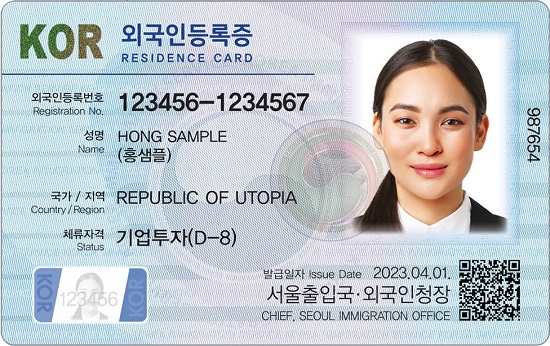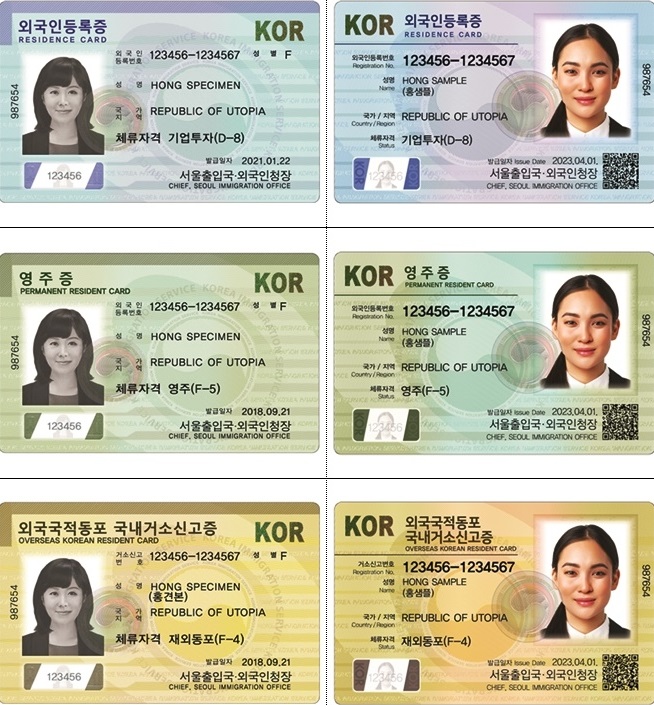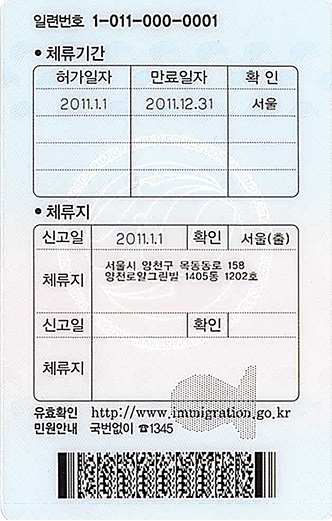With few exceptions outside of US military personnel stationed in Korea, all individuals who don’t have Korean citizenship and intend to live in Korea for longer than 6 months need to register with Immigration to get a Residence Card (외국인 등록증, 外國人 登錄證, oegugin deungnokjeung). Formerly called the Alien Registration Card and frequently shorted to ARC or Alien Card, the name changed in 2021 to Residence Card and the design radically changed in early 2023. This card not only fulfills your legal immigration requirement, but also gives you a resident registration number (주민등록번호, 住民登錄番號, jumin deungnok beonho –or– some variation on 등록번호, 登錄番號, deungnok beonho). The related law is the Resident Registration Act, Wikipedia has a page on Korea's resident registration number, and the Ministry of Stragety and Finance and Kyung Hee University wrote a 106-page book entitled The Evolution of the Resident Registration System in Korea as part of the national government's Knowledge Sharing Program (KSP).
The government is discussing changing the name of this card, so in the future it might be called something else. This master identification number will also be on your Korean driver’s license if you get one, is used to register at hospitals and medical clinics and tells the staff if you have national health insurance, can be used to create an account on Korean websites, can be used instead of your passport when banks ask for identification (you may need to bring both if you started the account with a passport but once your Residence Card number is on file you just need to bring the Residence Card), used to file taxes, etc. You can leave your passport at your residence in Korea as this ID card takes its place. This card is your official identification in Korea. Also having this card means you don’t need to fill out immigration paperwork when returning to Korea as all your information is already in their system.
To apply for a Residence Card, you will need to bring some paperwork to an Immigration office. Please see the list of locations each branch serves as they will not serve you if you go to the wrong branch. You will need an application form which is freely available in the lobby of Immigration. You will need a color passport photo 3.5 mm by 4.5 mm, which might be a different size than passport sized photos in your home country. While you can get passport photos at an Immigration branch, if you can bring one before you visit you can save some time. Additional paperwork differs by visa type. If you work at the Instiute for Basic Science (IBS) please ask your Center’s admin staff to help you prepare all the paperwork.
Application fee as of this writing is 30,000 KRW. You don’t pay the employee at the booth, but instead go to another part of the lobby and buy Government Revenue Stamps to pay for the visa. You will also have the choice to pick up your Residence Card or have it mailed to you. The mail system is very reliable and safe in Korea, so if you want to save time bring a little extra money to pay for the mailing service. An ATM is available in the lobby but sometimes has a long line as some Immigration procedures require payment at that specific ATM. To save time, make sure you have enough money before you arrive.

The identification card used by most foreign passport holders will be blue, as the image above shows. There is a green version for permanent residents, a reddish yellow version for ethnic Koreans born outside of Korea. Old (left) and new (right) versions of all three are below.

The 13-digit number with a dash in the middle of your ID card is your resident registration number. The first six digits are your birthday in YYMMDD format. So if you were born on October 30, 1983 the first six digits would be 831030. As birth information is common knowledge in Korea, the first six numbers aren’t seen as secret and don’t need to be protected unless you don’t wish to reveal your age. The first number after the dash identifies your citizenship as Korean or non-Korean, your gender, and which century you were born in.
9 – Male Korean (born 1800–1899)
0 – Female Korean (born 1800–1899)
1 – Male Korean (born 1900–1999)
2 – Female Korean (born 1900–1999)
3 – Male Korean (2000–present)
4 – Female Korean (2000–present)
5 – Male overseas resident (born 1900–1999)
6 – Female overseas resident (born 1900–1999)
7 – Male overseas resident (2000–present)
8 – Female overseas resident (2000–present)
Using our October birthday example for a male born outside of Korea, your ID would be 831030-5XXXXXX. The next two numbers were the regional government where a Korean national was born or the agency where an international resident was registered.
00-08 – Seoul
09-12 – Busan
13-15 – Incheon
16-25 – Gyeonggi Province
26-34 – Gangwon Province
35-39 – North Chungcheong Province
40 – Daejeon
41-47 – South Chungcheong Province
44 or 96 – Sejong City
48-54 – North Jeolla Province
55-66 – South Jeolla Province
55 or 56 – Gwangju
67-69 or 76 – Daegu
70-75
77-81 – North Gyeongsang Province
82-84
86-89, 90-92 – South Gyeongsang Province
85 or 90 – Ulsan
93-95 – Jeju Island.
The following two digits refer to the community center of that city/town/district. The next digit is a sequential number for when several babies of the same gender were born on the same day. The final number is a check digit used to confirm that the number has been written correctly. The check digit was generated using the following algorithm with digits corresponding to letters a through m:
m = [11 − {(2a + 3b + 4c + 5d + 6e + 7f + 8g + 9h + 2i + 3j + 4k + 5l) mod 11}] mod 10
With some effort to learn the meaning behind the codes, it has been possible to know where someone was born, which could potentially result is discrimination and unwillingly letting people know someone’s hometown. From October 2020, these last six-digits will become arbitrary for the issuance of new cards.
Under the large KOR on the top right is binary gender (성별, 性別, seongbyeol), and marked as either M or F. Under the resident registration number is your full legal name (성명, 姓名, seongmyeong) with family name written first followed by your given name and middle name. For example, the name Richard Andrew Moore will be written Moore Richard Andrew on a Residence Card and all in capital letters. In some Western publications it is normal to use this format, for example an author list or a list of cited references in research, but in these cases it is standard to include a comma after the family name if written first, example being Moore, Richard Andrew.
This format of FAMILY GIVEN MIDDLE used on Residence Card follows East Asian standards as we are in East Asia. But unfortunately this creates misunderstandings when applied to non-Asian names, especially as a comma is not added after the family name. Many Koreans believe Western names are written in Western order of GIVEN MIDDLE FAMILY which creates problems when trying to search for your name in a database and might also result in staff calling you by your family or middle name instead of your given name; which means Richard might be greeted with “Hello Moore” or “Mr. Andrew.”
Your name and resident registration number are also necessary for registering on a number of websites as they frequently check to make sure the legal name and resident registration number match to cut down on underage users and fake accounts. Registering for websites in Korea has historically been notoriously difficult for non-Koreans as the software systems were only designed for Korean nationals and Korean names. This means 13-digit resident registration numbers with a 5 or 6 after the dash frequently came up as invalid as only the Korean citizen databases were being checked. This has largely been fixed but still might exist on some legacy systems.
Korean names also don’t have spaces between the family and given name. As only 1% of the population living in Korea are not Korean citizens, the software connected with resident registration numbers has not be modified to use spaces with non-Korean names. This means when you need to use your legal name to register on a website or try to recover your account, you don’t type FAMILY GIVEN MIDDLE, but you write FAMILYGIVENMIDDLE without spaces and usually all in capital letters. So the name Richard Andrew Moore is written MOORERICHARDANDREW.
Under your legal name is the citizenship you hold (국가지역, 國家地域, gukga jiyeok). If you hold overseas dual citizenships, only the citizenship you used to enter Korea is the citizenship you declare to Immigration, and that is the only citizenship which will be written here. Under citizenship is the visa type you currently have (체류자격, 滯留資格, cheryu jagyeok). If your visa type changes, your Residence Card will be destroyed and a new one created with the new visa type. The bottom right shows when (발급일자, 發給日字, balgeup ilja) and where the Residence Card was issued.

The rear of your Residence Card will be vertical orientated with a serial number written on the top (일련번호, 一連番號, illyeonbeonho). The first box is labeled 체류기간 (滯留期間, cheryu gigan) and Duration of Stay is written on some cards. This box gets updated when your visa gets extended. Updates used to be written in pen but are now machine printed to avoid forgery. The ink within these boxes can sometimes get rubbed off, so you might want to cover these words with clear tape, being careful not to cover the blank spaces which might get used in the future. The first column is the date of approval (허가일자, 許可日字, heoga ilja), which is different from the date of issuance on the front of the card. The second column is the expiration date of your visa (만료일자, 滿了日字, mallyo ilja) and the city of the Immigration office which updated your status (확인, 確認, hwagin).
The second box is a simplified version compared to the sample image. The newer format has your registered address in Korea (체류지, 滯留地, cheryuji) and the date it was modified (신고일, 申告日, singoil). There are dual address systems that exist in Korea. Your address will be written both in the new system and then again with some of the old system in parenthesis. Having your address on your Residence Card can be very helpful if you forgot your address or need to have it written in Korean. This can make registering at a medical facility much easier, especially if you are feeling terrible. “First time here?” Instead of filling out the registration paper, you can give them your ID card as it has all the necessary information; not only for general patient registration, but for proving you have insurance as well.
You must update the government within two weeks of when you move, otherwise you’ll be hit with a financial penalty and have negative points against you, which can hurt your chances of upgrading to a better visa status in the future, i.e. F-2-7 “points-based visa” as you will now be minus one point towards the necessary 80. You can update your residency location by visiting an Immigration office or a local government office, including city hall (시청, 市廳, sicheong), district office (구, 區, gu), neighborhood office (동, 洞, dong), town office (읍, 邑, eup), or township office (면, 面, myeon). Some community centers can also do this but not all, so ask your Center's admin to contact them ahead of time to confirm. If you are trying to update your address more than two weeks after moving, you are only allowed to update your address with Immigration as you are in violation of Immigration law and only Immigration is allowed to deal with that situation.